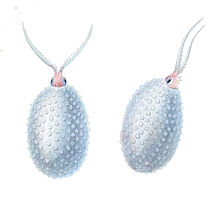
Cranchia scabra is a species of glass squid. It is the only species in the genus, and is fairly small (about 150 millimeters (5.9 in)). They reside in the epipelagic zones of the tropical Atlantic. The genus also contains bioluminescent species. Cranchia scabra are named after John Cranch who first described this species.
Anatomy and Morphology
Tubercles
The mantle is covered by large, multi-pointed cartilagenous tubercles. C. scabra are often characterized by complex tubercles which are projections or protuberances on their surface. The scanning electron microscope inspected the tubercles. Tubercles can be small and simple nodules, or large with a complex Maltese cross form. The tubercles may provide protection, but it is unclear how predators may be affected.
Dorsal and Ventral Chambers
These squids have a horizontal partition over the mantle cavity. The mantle cavity is divided into 2 dorsal chambers and 1 ventral chamber. An opening in the posterior end of the horizontal membrane connects the dorsal chamber to the ventral chamber. An inhalant opening on the head connects the exterior portion of the horizontal membrane between the dorsal and ventral chambers. A thin membrane is connected to the anterior border of the head and mantle, located along the borders of the dorsal and ventral chambers. This thin membrane prevents water from exiting the dorsal chamber. Water can exit the ventral chamber via a small funnel.
Photophores
Light-emitting organs, known as photophores, around the eyes allow them to see in the dark. This light can deter predators. Female squids have photophores on the tips of their arms which may attract mates.
| Cranchia scabra | |
|---|---|

| |
| Conservation status | |
 Least Concern (IUCN 3.1) | |
| Scientific classification | |
| Domain: | Eukaryota |
| Kingdom: | Animalia |
| Phylum: | Mollusca |
| Class: | Cephalopoda |
| Order: | Oegopsida |
| Family: | Cranchiidae |
| Subfamily: | Cranchiinae |
| Genus: | Cranchia Leach, 1817 |
| Species: | C. scabra |
| Binomial name | |
| Cranchia scabra Leach, 1817 | |
| Synonyms | |
| |
Habitat and Distribution
Cranchia scabra are distributed across the globe in tropical and subtropical open ocean waters. Paralarval and juvenile squids are found in the epipelagic to upper mesopelagic zones of the ocean. Adult squids move into the mesopelagic and bathypelagic zones, up to 2000 m deep.
Behavior
Movement
C. scabra are neutrally buoyant animals due to ammonia fluid located in their cavities. They change orientation and position with rapid movement of their fins. In captivity, C. scabra has been shown to contract its mantle which caused rapid backward movements over a distance of 3-4 body-lengths. Immediately after these contractions, the mantle maintained its contracted shape, but slowly recovered its original, globular shape. Since the mantle shape was very slowly regained and these contractions are used infrequently, researchers have suggested that these short movements are used as escape reactions, rather than continuous movement.
When disturbed, the squid often pulls its head and arms into the mantle cavity, and folds its fins tightly against the mantle to form a turgid ball. The squid may ink into the mantle cavity, making the ball opaque. This was thought to be an aberrant behavior due to the stress and confinement of shipboard aquaria, until the same inking behavior was seen in cranchiids from submersibles. The exact function of this behavior is unknown, but inking could help them change color or may be used as a chemical weapon against predators.
Diet
C. scabra are known to eat small fish, crustaceans, and other organisms of similar size.
Mating Behavior
Glass squids are of the class Cephalopoda and members of this class are gonochoric. Males perform displays to attract potential female mates. During the mating process, the male squids hold the female squids and insert the hectocotylus into the mantle cavity of the female squid. Fertilization occurs within this mantle cavity and embryos hatch into a planktonic stage prior to growing to their adult size.
Growth
C. scabra are some of the fastest growing squids. During the first 4–5 months of their development, they feed and grow very rapidly in epipelagic waters. They move into deeper waters to mature and spawn.
Statoliths are calcareous structures found in cephalopods which detect body accelerations throughout movement. The age and growth rates of these squids can be estimated through analysis of statolith microstructure. There are two growth zones in statolith microstructures: an inner, translucent postnuclear zone and an outer, pale white opaque zone. Researchers hypothesize that the translucent peripheral zones in C. scabra statoliths develop later, after the transition to deep water.
References
- Damkaer, David M. (2002). The copepodologist's cabinet: a biographical and bibliographical history. Memoirs of the American Philosophical Society held at Philadelphia for promoting useful knowledge. Philadelphia, Pa: American Philosophical Society. ISBN 978-0-87169-240-5.
- Dilly, P. N.; Nixon, Marion (July 1976). "The dermal tubercles of Cranchia scabra (Mollusca, Cephalopoda); surface structure and development". Journal of Zoology. 179 (3): 291–295. doi:10.1111/j.1469-7998.1976.tb02297.x. ISSN 0952-8369.
- ^ Clarke, Malcolm R. (October 1962). "Respiratory and Swimming Movements in the Cephalopod Cranchia Scabra". Nature. 196 (4852): 351–352. doi:10.1038/196351a0. ISSN 0028-0836.
- ^ "Creature Feature: Glass squid". twilightzone.whoi.edu. Retrieved 2024-03-26.
- Barratt, I.; Allcock, L. (2014). "Cranchia scabra". IUCN Red List of Threatened Species. 2014: e.T162941A955561. doi:10.2305/IUCN.UK.2014-1.RLTS.T162941A955561.en. Retrieved 19 November 2021.
- ^ Julian Finn (2016). "Cranchia scabra Leach, 1817". World Register of Marine Species. Flanders Marine Institute. Retrieved 26 February 2018.
- ^ "Cranchia scabra, Rough cranch squid". www.sealifebase.ca. Retrieved 2024-03-26.
- "Creature Feature: Glass squid". twilightzone.whoi.edu/. Retrieved 2024-03-26.
- Arhipkin, Alexander (1996). "Age and growth of planktonic squids Cranchia scabra and Liocranchia reinhardti (Cephalopoda, Cranchiidae) in epipelagic waters of the central-east Atlantic". Journal of Plankton Research. 18 (9).
External links
- "CephBase: Cranchia scabra". Archived from the original on 2005-08-17.
- Tree of Life web project: Cranchia scabra
| Taxon identifiers | |
|---|---|
| Cranchia scabra |
|